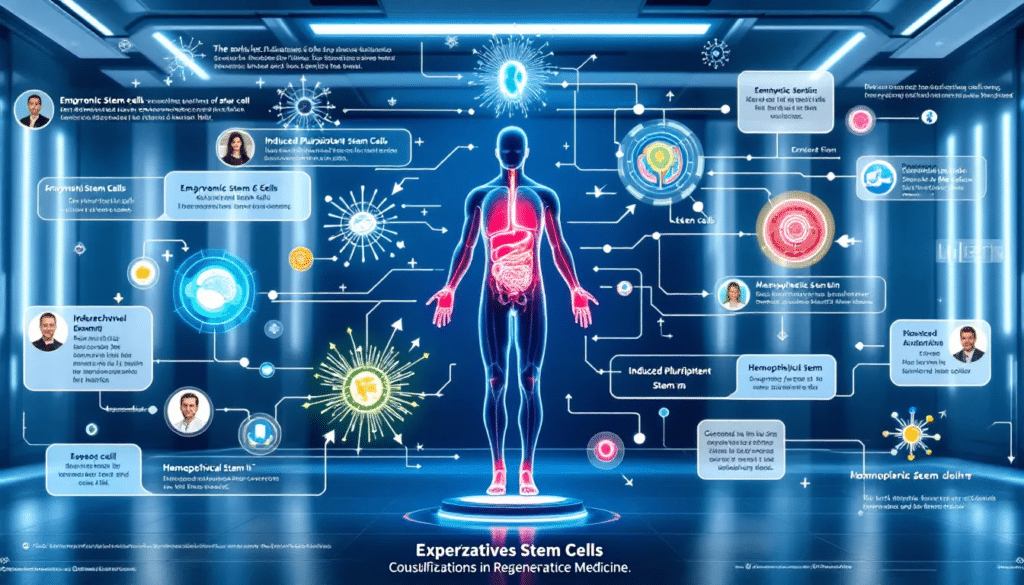Stem cell treatments have shown remarkable success in treating conditions like blood cancers, osteoarthritis, and neurodegenerative diseases. These therapies offer new hope by effectively repairing damaged tissues and restoring function. In this article, we highlight the most successful stem cell treatments and their impact on modern medicine.
Key Takeaways
Stem cells, including embryonic, adult, and induced pluripotent types, are crucial in regenerative medicine, offering potential treatments for a range of diseases.
Success rates for stem cell therapies remain high, with studies showing 85% of patients experiencing improvements, but outcomes depend on individual health conditions and treatment protocols.
Ongoing advancements and research in stem cell applications, particularly in hematopoietic and mesenchymal stem cell therapies, highlight the transformative potential of these treatments in improving patient health and quality of life.
Understanding Stem Cells and Their Potential

Stem cells are pivotal in regenerative medicine, capable of developing into various cell types and repairing damaged tissues.
The main types of stem cells include:
Embryonic stem cells, derived from human embryos, are considered the most versatile due to their pluripotent nature, meaning they can develop into any cell type in the body.
Adult stem cells, which are found in various tissues and have a more limited differentiation potential.
Induced pluripotent stem cells, which are adult cells that have been genetically reprogrammed to an embryonic stem cell-like state.
This versatility makes them a powerful tool for personalized medicine and regenerative therapies.
Adult stem cells, found in limited quantities in adult tissues, have a more restricted ability to differentiate compared to embryonic stem cells. They primarily become cell types within the tissue they reside, playing a crucial role in tissue repair and regeneration. Despite their limitations, adult stem cells have been successfully used in treatments for diseases like leukemia and Parkinson’s disease.
Induced pluripotent stem cells (iPSCs) have gained significant attention due to their ability to be generated from somatic cells, such as skin cells, allowing for personalized medicine without the ethical concerns associated with embryonic stem cells. These cells share the same pluripotent characteristics as embryonic stem cells, making them a promising avenue for stem cell-based therapies.
The potential applications of stem cells are vast, ranging from treating neurodegenerative diseases to diabetes. Stem cell therapy is being investigated for its ability to boost healing and treat previously incurable conditions, showcasing the promise of regenerative medicine. For instance, clinical trials using human embryonic stem cell (hESC)-based therapy have shown success in treating Stargardt’s macular dystrophy, a condition that leads to vision loss.
Advancements in stem cell research continue to highlight their therapeutic potential. Cardiovascular research, for example, is exploring the use of stem cells to repair heart tissues, which could revolutionize the treatment of heart diseases. The ability of stem cells to differentiate into specialized cells, such as heart muscle cells and neural cells, underscores their importance in regenerative medicine.
Stem cells derived from bone marrow, known as hematopoietic stem cells, are particularly effective in treating blood-related conditions through bone marrow transplants. These cells can regenerate the immune system and produce healthy blood cells, making them a cornerstone in stem cell treatment of blood cancers.
Stem cell therapy is not limited to treating diseases; it also holds potential for enhancing overall health and longevity. Stem cells enhance tissue repair and regeneration, improving the quality of life for those with chronic conditions. The ongoing research and clinical trials continue to expand our understanding of stem cell biology and their applications in medicine.
The promise of stem cell-based therapies lies in their ability to target the root cause of diseases, offering long-term solutions rather than merely alleviating symptoms. This revolutionary approach has the potential to transform the landscape of modern medicine, providing new hope for patients worldwide through stem cell based therapy.
Evaluating Successful Stem Cell Treatments

The success of stem cell treatments is measured by the percentage of patients achieving desired therapeutic outcomes, such as symptom reduction and improved quality of life. Evaluating these treatments involves clinical assessments, lab tests, and patient-reported outcomes. These assessments provide a comprehensive view of how well the treatment is working and its impact on the patient’s health.
One significant indicator of success is the high percentage of patients reporting sustained improvement after treatment. Studies have shown that 85% of patients across various stem cell therapies experience such improvements. This high success rate underscores the effectiveness of stem cell treatments in addressing a wide range of medical conditions.
The timeline for observing the effects of stem cell therapy can vary, but generally, measurable improvements can be seen within 3-6 months post-treatment. This period allows the transplanted cells to integrate into the patient’s body and begin the healing process. Both short-term and long-term benefits are considered to determine the overall effectiveness of the therapy.
In clinical trials, the success of stem cell therapy is also evaluated by comparing the outcomes with those of standard treatments. This comparative approach helps to establish the superiority or additional benefits of stem cell-based therapies. By rigorously assessing the results, researchers can identify which treatments hold the most promise and refine protocols to enhance their effectiveness.
Success rates of stem cell treatments vary based on individual patient conditions and the specific disease. Factors such as the patient’s overall health, the source of the stem cells, and adherence to post-treatment protocols can all influence the outcomes. Therefore, personalized treatment plans are often necessary to achieve the best results.
With advancements in stem cell research and clinical trials, evaluation processes for these therapies are becoming more sophisticated. This progress ensures that the treatments are safe, effective, and tailored to meet the unique needs of each patient. Refining these processes continually enhances the success rates of stem cell therapies, offering new hope to patients globally.
Hematopoietic Stem Cell Transplants: A Proven Success

Hematopoietic stem cells (HSCs) have proven to be a cornerstone in the treatment of blood-related conditions, particularly through bone marrow transplants. These stem cells are responsible for producing healthy blood cells and regenerating the immune system, making them crucial for treating blood cancers and other hematologic disorders.
Hematopoietic stem cell transplants (HSCT) for blood cancers show impressive success rates, with studies indicating 60-70% efficacy. This high rate is particularly significant for patients with conditions such as acute lymphoblastic leukemia (ALL) and acute myeloid leukemia (AML). For children with very high-risk ALL undergoing allogeneic bone marrow transplant, contemporary protocols have improved the 5-year overall survival rate to 65% following a stem cell transplant.
Acute myeloid leukemia patients treated with contemporary allogeneic hematopoietic cell transplantation have exhibited a remarkable 5-year overall survival rate of 74%. These survival rates highlight the effectiveness of HSCT in providing long-term remission and improving patient outcomes. Additionally, 92% of Hodgkin lymphoma patients are alive three years post-transplant, showcasing the success of this treatment in managing blood cancers.
Autologous stem cell transplants significantly benefit multiple myeloma patients. The three-year survival rate for these patients is 79%. Similarly, non-Hodgkin lymphoma patients have a three-year survival rate of 72% after undergoing HSCT. These statistics underscore the life-saving potential of hematopoietic stem cell transplants and their role in treating various types of blood cancers.
Recent cohorts have shown significantly lower rates of death related to infection and relapse compared to earlier cohorts in hematopoietic cell transplant studies. This improvement can be attributed to advancements in transplantation techniques, better supportive care, and improved patient selection criteria. Patients receiving haploidentical donor transplants in recent studies achieved an 88% survival rate over five years, further demonstrating the success of modern HSCT protocols.
One key factor influencing the success of HSCT is the disease stage at the time of transplantation. Survival outcomes for patients in first complete remission at the time of transplantation are significantly better than for those with advanced disease. Early intervention and timely transplantation can therefore play a crucial role in achieving better outcomes for patients undergoing HSCT.
Continuous improvements in hematopoietic stem cell transplants underscore the transformative potential of stem cell-based therapies for blood cancers and other hematologic disorders. Ongoing research and advancements make the future of HSCT promising, offering new hope to patients and their families.
Mesenchymal Stem Cell Therapy for Joint Repair
Mesenchymal stem cells (MSCs) are a promising treatment for joint repair, particularly in osteoarthritis. Sourced from tissues like bone marrow and adipose tissue, these cells can differentiate into cartilage, making them ideal for joint repair. Adipose-derived MSCs, in particular, have shown greater proliferation and differentiation potentials compared to those derived from bone marrow.
Clinical studies have demonstrated significant improvements in knee osteoarthritis patients treated with MSCs. These improvements include pain relief and enhanced joint function, providing a viable alternative to traditional treatments. Intra-articular administration of MSCs has shown promising outcomes in clinical trials, with patients reporting improved scores on pain and function assessments.
Long-term follow-up studies have confirmed the sustained benefits of MSC therapy for knee osteoarthritis. Patients continue to experience improvements in symptoms and joint function years after the treatment, highlighting the long-lasting effects of MSCs. This sustained improvement underscores the potential of MSC therapy as a long-term solution for joint repair.
Stem cell therapy offers a less invasive alternative to surgical interventions for osteoarthritis. By promoting the regeneration of cartilage and reducing inflammation, MSCs can help alleviate the symptoms of osteoarthritis and improve the quality of life for patients.
The effectiveness of mesenchymal stem cells in treating osteoarthritis and other joint conditions showcases the potential of stem cell-based therapies in regenerative medicine. With ongoing research and clinical trials, MSC therapy continues to evolve, offering new hope to patients suffering from joint-related ailments.
Neural Stem Cells in Treating Neurodegenerative Diseases
Neurodegenerative diseases, such as Parkinson’s disease and amyotrophic lateral sclerosis (ALS), present significant challenges for treatment. Neural stem cells (NSCs) show great potential in regenerating damaged neural tissues for these conditions. Ongoing clinical trials are investigating the efficacy of stem cell therapies in treating neurological disorders like Alzheimer’s and Parkinson’s, showing early promise in outcomes.
Transplanted neural stem cells can integrate into existing neural networks, enhancing the brain’s regenerative capacity and potentially improving function. This integration can help restore lost neural functions and slow the progression of neurodegenerative diseases. Clinical studies have highlighted that patients with ALS who received fetal neural stem cells experienced no disease progression for up to 18 months, and moderate improvements were noted in Parkinson’s disease patients after similar treatments.
The potential of neural stem cells in treating neurodegenerative diseases lies in their ability to replace lost or damaged neurons, offering a new approach to managing these debilitating conditions. As research continues, the hope is that stem cell-based therapies will provide effective treatments for a range of neurological disorders, improving the lives of patients and their families.
Umbilical Cord Blood Stem Cells: Versatile and Effective

Umbilical cord blood stem cells are recognized for their versatility and effectiveness in treating various medical conditions. These stem cells can be utilized for treating cancers, immune deficiencies, and genetic disorders. Some pulmonary diseases treated with umbilical cord blood-derived mesenchymal stem cells include bronchopulmonary dysplasia (BPD), chronic obstructive pulmonary disease (COPD), acute respiratory distress syndrome (ARDS), and COVID-19-induced ARDS.
Umbilical cord-derived MSCs provide higher immunomodulatory effects and proliferation capabilities, enhancing their therapeutic potential. Additionally, cord blood can be collected safely and is considered a non-invasive procedure for both the mother and infant. This ease of collection makes umbilical cord blood stem cells an attractive option for stem cell-based therapies.
Umbilical cord blood stem cells are easier to obtain and culture, as they are considered a waste product after birth, allowing for noninvasive collection. Their accessibility and high therapeutic potential make umbilical cord blood stem cells highly successful for elective treatments. Their versatility and effectiveness continue to drive research and clinical applications, offering new hope for patients with various medical conditions.
Induced Pluripotent Stem Cells: Emerging Success Stories
Induced pluripotent stem cells (iPSCs) mark a groundbreaking advancement in stem cell research. Created by reprogramming adult cells, such as skin cells, iPSCs behave like embryonic stem cells, possessing the ability to differentiate into any cell type in the body. Pioneered by Shinya Yamanaka in 2006, this innovation opened new avenues for personalized medicine and regenerative therapies.
A significant advantage of iPSCs over embryonic stem cells is their ethical acceptability, as they do not involve human embryos. This ethical advantage has made iPSCs a highly attractive source for cell-based therapies, avoiding the controversies associated with embryonic stem cell research. Additionally, iPSCs can proliferate indefinitely, offering endless possibilities in treatment and research.
Clinical trials with iPSCs have shown promising results. For instance, in one trial, patients experienced corrected visual acuity in the treated eye, showcasing the successful application of iPSCs in treating vision impairment. These success stories highlight iPSCs’ potential in treating various medical conditions and improving patient outcomes.
Another trial focused on iPSC-based autologous transplantation, where complications such as abnormal proliferation, systemic malignancy, and rejection of transplanted cells were closely monitored. This rigorous approach ensures the safety and efficacy of iPSC therapies, paving the way for their broader clinical application.
As research on iPSCs continues to advance, their potential in regenerative medicine becomes increasingly apparent. These cells offer a promising future for personalized treatments, allowing for tailored therapies that address the specific needs of individual patients. The success stories of iPSCs serve as a testament to the transformative potential of stem cell-based therapies in modern medicine.
Clinical Trials and Regulatory Approvals
The landscape of stem cell therapies is evolving with significant advancements in clinical trials and regulatory approvals. Recent developments have greatly improved the evaluation processes for stem cell therapies, ensuring their safety and efficacy in clinical settings. These advancements have led to exponential growth in clinical trials, expanding the potential applications of stem cell-based treatments.
A major hurdle for stem cell clinical trials is the lack of comprehensive regulatory approvals. The absence of full regulatory approval affects the progress and implementation of stem cell therapies. Globally, significant efforts are being made to establish regulatory guidelines and standards to enhance patient safety and streamline the approval process.
Patient eligibility for stem cell clinical trials is determined through a screening application process, ensuring only suitable candidates participate. All stem cell protocols must receive Institutional Review Board (IRB) approval to ensure safety and efficacy before implementation. This rigorous oversight helps protect participants and maintain high standards in stem cell research.
One notable example of ongoing clinical trials is the Phase I/II trial conducted by ViaCyteTM in collaboration with Harvard University, focusing on the efficacy and safety of stem cell applications. These trials represent a critical step in translating stem cell research into viable treatments, offering new hope for patients with various medical conditions.
As the regulatory landscape for stem cell therapies continues to evolve, the hope is that streamlined approvals and robust clinical trials will pave the way for broader access to these revolutionary treatments. By ensuring rigorous evaluation and adherence to safety standards, the medical community can unlock the full potential of stem cell-based therapies.
Factors Influencing Stem Cell Therapy Success
Various factors influence the success of stem cell therapy, each crucial in determining treatment effectiveness. A primary factor is the source of stem cells. Whether from bone marrow, adipose tissue, or umbilical cord blood, the source significantly impacts therapy outcomes. Different sources offer unique advantages and disadvantages, affecting the proliferation, differentiation, and immunomodulatory capabilities of the stem cells.
Individual patient conditions and overall health status critically determine the success of stem cell therapy. Patients with healthier lifestyles and fewer preexisting health conditions generally experience better responses to stem cell treatments. Additionally, patients who engage in rehabilitation and follow post-treatment protocols tend to achieve better long-term outcomes.
Processing and administration techniques are key factors influencing stem cell therapy effectiveness. The dosage of stem cells administered can critically impact the success of the therapy, with appropriate dosing being essential for optimal results. Moreover, regular follow-ups are essential for monitoring progress and making necessary adjustments to the treatment plan, ensuring continued success.
The specific disease being treated is crucial in determining stem cell therapy success rates. Different conditions may respond differently to stem cell treatments, necessitating tailored approaches for each patient. This individualized treatment plan ensures that the therapy is aligned with the unique needs and circumstances of the patient.
Understanding and addressing these factors enhances stem cell therapy success rates, providing more effective treatments for a broad range of medical conditions. Continuous research and improvements in stem cell technology and protocols will further contribute to the success of these revolutionary therapies.
Ethical Considerations in Stem Cell Research
Ethical considerations in stem cell research are complex and multifaceted, often sparking intense debate. A primary ethical concern is the use of embryonic stem cells, sourced from excess embryos created during in vitro fertilization. Creating embryos specifically for research raises ethical objections related to respecting nascent human life.
Embryonic stem cell research involves embryo destruction, raising significant ethical questions about their moral status. This ethical challenge has prompted the establishment of oversight committees to review stem cell research and address both scientific and ethical concerns. These committees play a crucial role in ensuring that research practices adhere to ethical standards while advancing scientific knowledge.
Induced pluripotent stem cells (iPSCs) provide an ethical alternative to human embryonic stem cells, not requiring embryos. However, concerns over iPSCs include the potential for human cloning and tumor formation, which necessitate careful monitoring and regulation. The National Institutes of Health created guidelines for embryonic stem cell research in 2009, providing a framework for ethical research practices.
Informed consent is a critical ethical consideration in stem cell research, particularly for embryo and gamete donations. Ensuring that donors are fully informed about the potential uses and implications of their donations is essential for maintaining ethical standards.
Global efforts aim to establish uniform regulatory standards to enhance patient safety in stem cell research. These efforts seek to balance the potential benefits of stem cell therapies with the ethical considerations, ensuring that research is conducted responsibly and ethically. By addressing these ethical concerns, the medical community can advance stem cell research while respecting the moral values of society.
Future Perspectives on Stem Cell Therapies

The future of stem cell therapies is promising, driven by gene-editing innovations like CRISPR, enhancing treatment precision. These advancements allow for more accurate targeting of diseases, reducing the risk of complications and improving patient outcomes.
Integrating precision medicine with stem cell approaches aims to develop individualized treatments for various conditions. By tailoring therapies to the unique genetic makeup of each patient, the potential for effective and personalized treatments increases significantly.
Research is underway to utilize stem cells for ocular regeneration, targeting diseases like macular degeneration. Emerging applications of stem cell therapy include its use in immunotherapy targeting specific cancers. Additionally, the use of bioengineered cardiac patches using stem cells is being explored for heart tissue regeneration after myocardial infarctions.
As these innovative applications continue to develop, the future of stem cell therapies looks promising. The potential to revolutionize the treatment of various medical conditions and improve patient outcomes is vast, offering new hope for patients and their families.
Stem Cells LA: A leader In Regenerative Medicine Across Los Angeles
Stem Cells LA stands out as a leader in regenerative medicine, providing tailored treatments for a variety of needs, including adult stem cell therapy. The clinic offers a range of services, including autoimmune treatment, hair loss treatment with stem cells and exosomes, and injury/pain management treatments with stem cell injections.
What sets Stem Cells LA apart is their commitment to patient care. The team at Stem Cells LA focuses on making patients feel as comfortable as possible and ensures they are well-informed about their treatment options and considerations. This patient-centered approach enhances the overall treatment experience and contributes to better outcomes.
Unlike many other clinics that may take a less thorough approach, Stem Cells LA takes the time to fully address each patient’s situation, doing their best to ensure effective results. This dedication to excellence has established Stem Cells LA as a trusted name in regenerative medicine across Los Angeles.
Offering cutting-edge treatments and prioritizing patient care, Stem Cells LA leads in stem cell therapy, providing new hope and improved health outcomes.
Summary
The journey through the world of stem cell treatments reveals the immense potential and transformative power of these therapies. From hematopoietic stem cell transplants for blood cancers to mesenchymal stem cell therapy for joint repair, the successes are numerous and impactful. Neural stem cells offer hope for neurodegenerative diseases, while umbilical cord blood stem cells and induced pluripotent stem cells continue to showcase their versatility and effectiveness.
The advancements in clinical trials, regulatory approvals, and ethical considerations ensure that stem cell therapies are safe, effective, and ethically sound. As research progresses, the future of stem cell therapies looks bright, with new innovations and applications on the horizon. The promise of personalized and regenerative medicine is becoming a reality, offering new hope to patients worldwide.
Frequently Asked Questions
What are the main types of stem cells?
The main types of stem cells are embryonic, adult, and induced pluripotent stem cells, each distinguished by specific characteristics and significant potential for regenerative medicine applications. This diversity underscores the importance of stem cell research in advancing medical treatments.
How is success in stem cell therapy evaluated?
Success in stem cell therapy is evaluated through clinical assessments such as lab tests and patient-reported outcomes, focusing on symptom reduction, improved quality of life, and sustained improvements over time. These indicators are pivotal in determining the therapy’s effectiveness.
What are the ethical concerns associated with stem cell research?
The ethical concerns associated with stem cell research center on the destruction of embryos in obtaining embryonic stem cells. While induced pluripotent stem cells provide an alternative, issues related to human cloning and tumor formation persist.
What factors influence the success of stem cell therapy?
The success of stem cell therapy is influenced by the source of stem cells, the individual patient’s condition, processing and administration techniques, and adherence to post-treatment protocols. Each of these factors plays a critical role in determining the overall effectiveness of the therapy.
What is the future outlook for stem cell therapies?
The future outlook for stem cell therapies is indeed promising, driven by advancements in gene-editing technologies and precision medicine, particularly in areas such as ocular regeneration, cancer immunotherapy, and cardiac tissue regeneration. Such progress suggests a significant potential for new treatment options and improved patient outcomes.


